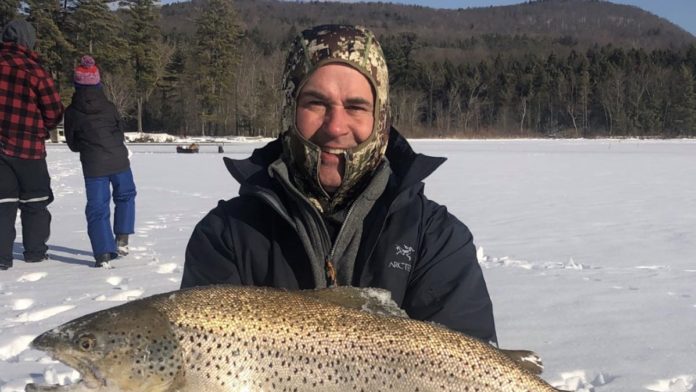| Correspondent
Fishing has been bi-polar in extremes and mostly arctic in comfort. While Connecticut and Rhode Island cod boats haven’t been able to even leave the docks in several weeks, ice fishermen across our region have been finding exceptional, safe opportunities — the best in years — on all but our very deepest waters. Even on Cape Cod, where walkable water has too long been a rarity, anglers are pulling big fish through the ice.
A 12-pound pike was caught at Heard Pond in Wayland. Several other gator-jawed pike have been taken from Barton Cove at Turners Falls and the Merrimack River, too. But trout under the ice have stolen the show.
Shiner-using tilt fishermen at Whitehall Reservoir and Comet Pond have done particularly well while a wall-hanger 5-pound, 13-ounce brown was hauled out of Walden Pond. But the top fish caught so far this winter is unequivocally a 15-pound, 13-ounce brown trout squeezed through an 8-inch ice hole on Feb. 6 by Hinsdale’s Jamie Pollard in the Stockbridge Bowl.
Swallowing a big shiner deep, it fought hard for 15 minutes, bringing icy pain to Pollard’s hands. When this fish-of-a-lifetime was finally pulled out, it looked much like a big salmon. But salmon have slightly forked tails, while brown trout have square tails.
The giant brown wasn’t officially checked in until a full day later and surely weighed substantially more when it flopped on the ice, though it’s unlikely that it would have broken our state record of 19 pounds, 10 ounces, caught by Dana Deblois in Wachusett Reservoir 55 years ago. Intriguingly, though, Pollard’s fish was at least an inch longer than the record. It’s so important to get a record-threatening fish officially weighed immediately after capture before it inevitably loses weight.
Monster trophy browns lurk in Stockbridge Bowl and several other deep, cold and clean commonwealth waters because surplus brood stock no longer spawning in our Palmer and Sandwich hatcheries were released by MassWildlife’s staff in 2016, 2017 and 2020.
All of those fish were between 3 and 10 pounds, so this giant from that stock had been feeding well in the Bowl for several years. MassWildlife’s stocking and management strategies annually provide hard-fishing anglers the exciting opportunity to catch huge trophies.
If you’re a fly fisherman and want a chance to hook a big brown trout, you don’t have to go ice fishing with tilts and jigs. The Harrison brothers, two of the top river guides in the country, are now floating the Deerfield River. Numerous anglers have reported great float fishing on the upper Deerfield with them this winter.
Early on, we had very low water this year, but Tom Harrison is happy to report that “flows have been up between 800-1200 since November which makes for ideal conditions for winter fish activity from Fife Brook dam all the way to Shelburne Falls. We’ve been catching brown and rainbow trout on large streamers and big attracter nymphs like stones, San Juan’s, and egg patterns. A client even caught two rainbows on the same drift on a 2-fly nymph rig last week. That is rare for a winter day!”
Down in Connecticut, wading anglers on the frigid 33-degree Farmington River were having hard-earned, lucky-to-catch-a-couple-fish action on caddis flies, nymphs, and streamers.
Five hours west in New York, Salmon River area steelhead anglers have been facing frigid conditions, shelf ice, slush — and getting skunked. A few very skilled fly fishermen are occasionally scoring with small eggs and stonefly patterns fished deep.
Access for all
This land is your land. This land is my land — unless somebody else has enough money to buy it and keep us out. Or if somebody knows someone in position to restrict access.
America’s most treasured lands, most of us would agree, should belong to all Americans — no matter how loud money and influence talk. That’s the spirit behind our national parks. But someone up in Rockport recently exerted influence that put into question the fairness of access to Andrews Point, one of our state’s most beautiful natural sites. Hunters who have been denied access can emotionally relate to this scenario.
Back in the 1980s, I drove up the spectacular northern coast of California — and then entered Oregon, where the ocean scenery became even more intimately close and uninterrupted. Back then, no one was allowed to build alongside it.
There were no gaudy hotels, no bill boards, no gas stations, or any other ugly commercial structures defacing the raw beauty that belonged to everyone there. I had never imagined that a state could possess the esthetic and environmental values to keep so much pristine land for everyone’s pleasure.
It turned out that Oregonians passed a law back in 1913 that set aside the state’s 362 miles of wet-sand shoreline as a public highway. Back in 1966, a hotel owner blocked passage to the beach in front of his business, raising enough public resentment that their legislature passed the Oregon Beach Bill that allowed unrestricted public beach access below any and all existing vegetation.
I thought of that beautiful coast’s easy accessibility after receiving a distressing message from Uxbridge bird authority and tour leader, Strickland Wheelock. He had just returned from a trip to Rockport’s Andrews Point.
If you haven’t walked out on Andrews Point to watch its winter seabird show, you’ve missed one of America’s most beautiful and rewarding wildlife displays. For the last four decades, I’ve made at least one annual stop there to revel in close observations of purple sandpipers on the rocks and harlequin ducks, loons, grebes, eiders, scoters, goldeneyes, buffleheads, mergansers, razorbills, guillemots, dovekies, and murres offshore.
Those who have regularly chronicled their sightings at the Point over the last century have added invaluable records to our avian history. From an ornithologist’s viewpoint, Andrews Point has been a natural institution of education to study at and write stories about. It’s been nothing less than a regional treasure to protect, share, learn from, and be proud of. But trouble brewed in paradise.
Approaching the Point, Wheelock found a “No Parking” sign placed at the one and only spot remaining to access Andrews Point’s public trails. Complaining neighbors, tired of visitors parking along their streets in front of their houses, shouted loud enough to close access to all but themselves.
The last time I was there, every street in the neighborhood was marked with no parking signs. The nearest legal parking is on the inland side of Phillips Avenue, several blocks away. That’s literally a haul in winter when you have to wear boots, heavy clothing, and carry binoculars and telescopes on tripods.
For decades, we enjoyed just one tiny and convenient access located at the very end of Point de Chene Avenue. The little dirt parking area always allowed us to get out on the adjacent rocks to scan the bird-rich waters. There was an unwritten code to park briefly, scan purposefully, and leave politely for other birders to enjoy the same privilege.
It was unthinkable that that very last access point would ever be eliminated by a “No Parking” sign. Many influential voices from the BBC to Mass Audubon — many of whom bring considerable tourist dollars to Rockport — complained irately. Someone that controls the placement of no parking signs heard the gripes — and it was quickly taken down. At least for the moment. Maybe until summer visiting fishermen line the street day and night this summer right in front of Rockport taxpayers’ homes.
Those who know our access laws point to Chapter 91 of the Massachusetts Public Waterfront Act as a recourse to guarantee permanent reopening of that last tiny parking spot.
Wheelock’s rant can help us appreciate the battle that MassWildlife annually wages on behalf of our sportsmen and naturalists to provide more and better access to all of our hunting, fishing, and wildlife observation areas.
Contact Mark Blazis at markblazissafaris@gmail.com
Credit: Source link































